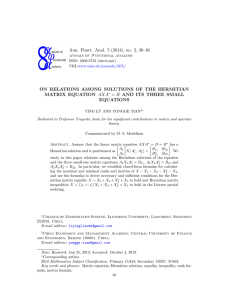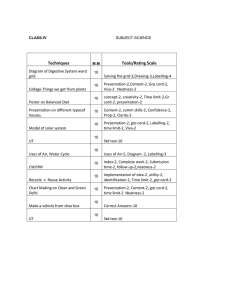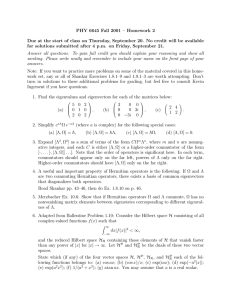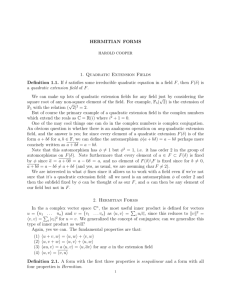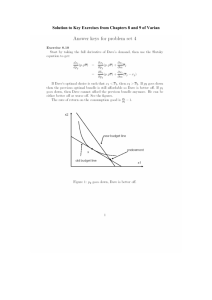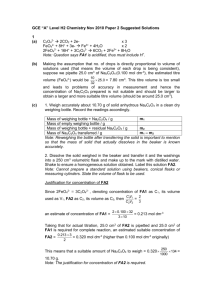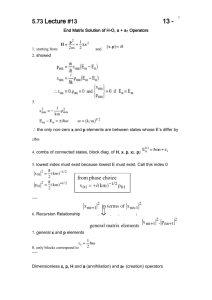Ann. Funct. Anal. 5 (2014), no. 2, 30–46 MATRIX EQUATION AXA
advertisement
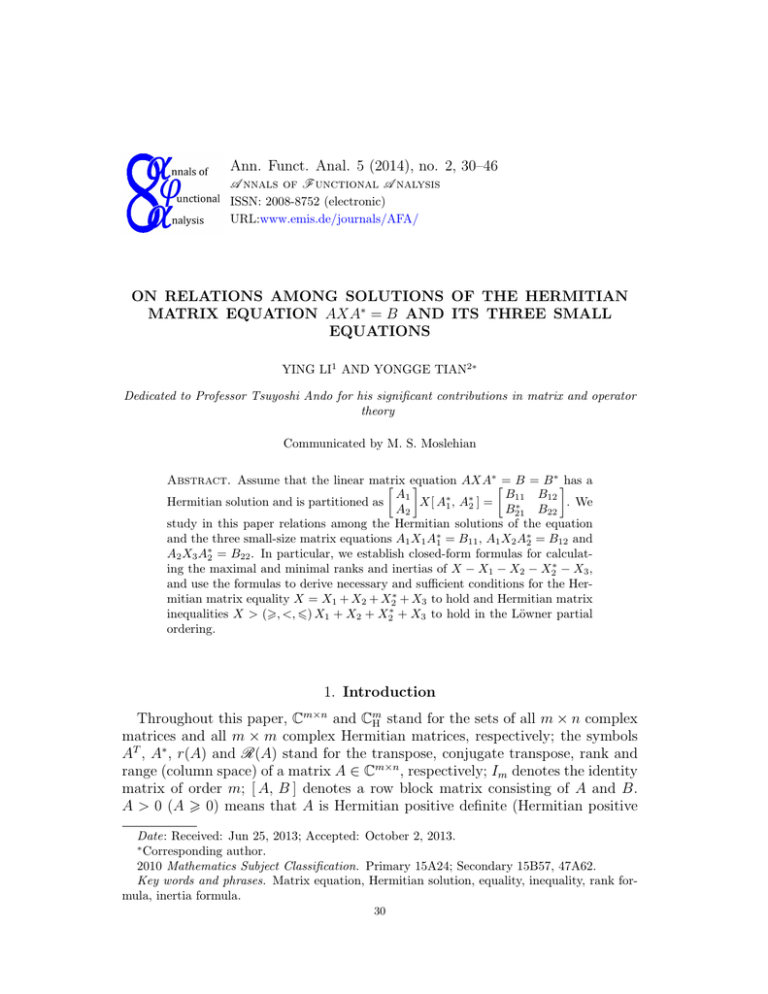
Ann. Funct. Anal. 5 (2014), no. 2, 30–46
A nnals of F unctional A nalysis
ISSN: 2008-8752 (electronic)
URL:www.emis.de/journals/AFA/
ON RELATIONS AMONG SOLUTIONS OF THE HERMITIAN
MATRIX EQUATION AXA∗ = B AND ITS THREE SMALL
EQUATIONS
YING LI1 AND YONGGE TIAN2∗
Dedicated to Professor Tsuyoshi Ando for his significant contributions in matrix and operator
theory
Communicated by M. S. Moslehian
Abstract. Assume that the linear matrix
AXA∗= B = B ∗ has a
equation
A1
B11 B12
Hermitian solution and is partitioned as
X[ A∗1 , A∗2 ] =
. We
∗
A2
B21
B22
study in this paper relations among the Hermitian solutions of the equation
and the three small-size matrix equations A1 X1 A∗1 = B11 , A1 X2 A∗2 = B12 and
A2 X3 A∗2 = B22 . In particular, we establish closed-form formulas for calculating the maximal and minimal ranks and inertias of X − X1 − X2 − X2∗ − X3 ,
and use the formulas to derive necessary and sufficient conditions for the Hermitian matrix equality X = X1 + X2 + X2∗ + X3 to hold and Hermitian matrix
inequalities X > (>, <, 6) X1 + X2 + X2∗ + X3 to hold in the Löwner partial
ordering.
1. Introduction
Throughout this paper, Cm×n and Cm
H stand for the sets of all m × n complex
matrices and all m × m complex Hermitian matrices, respectively; the symbols
AT , A∗ , r(A) and R(A) stand for the transpose, conjugate transpose, rank and
range (column space) of a matrix A ∈ Cm×n , respectively; Im denotes the identity
matrix of order m; [ A, B ] denotes a row block matrix consisting of A and B.
A > 0 (A > 0) means that A is Hermitian positive definite (Hermitian positive
Date: Received: Jun 25, 2013; Accepted: October 2, 2013.
∗
Corresponding author.
2010 Mathematics Subject Classification. Primary 15A24; Secondary 15B57, 47A62.
Key words and phrases. Matrix equation, Hermitian solution, equality, inequality, rank formula, inertia formula.
30
HERMITIAN MATRIX EQUATION
31
semi-definite). Two Hermitian matrices A and B of the same size are said to
satisfy the inequality A > B (A > B) in the Löwner partial ordering if A − B is
positive definite (positive semi-definite). The Moore–Penrose inverse of a matrix
A ∈ Cm×n , denoted by A† , is defined to be the unique matrix X ∈ Cn×m satisfying
the following four matrix equations
(i) AXA = A, (ii) XAX = X, (iii) (AX)∗ = AX, (iv) (XA)∗ = XA.
Further, denote EA = Im − AA† and FA = In − A† A. The ranks of EA and
FA are given by r(EA ) = m − r(A) and r(FA ) = n − r(A). The inertia of A is
defined to be the triplet In(A) = { i+ (A), i− (A), i0 (A) }, where i+ (A), i− (A) and
i0 (A) are the numbers of the positive, negative and zero eigenvalues of A counted
with multiplicities, respectively. The two numbers i+ (A) and i− (A) are usually
called partial inertia of A. For a matrix A ∈ Cm
H , both r(A) = i+ (A) + i− (A) and
i0 (A) = m − r(A) hold.
Consider the following well-known Hermitian linear matrix equation
AXA∗ = B,
(1.1)
n×n
where A ∈ Cm×n and B ∈ Cm
is an unknown matrix.
H are given, and X ∈ C
Eq. (1.1) is one of the simplest linear matrix equations with symmetric pattern,
which has attracted much attention of many authors since 1970s. If the known
matrices in (1.1) are given in partitioned form
m1 ×m2
i
Ai ∈ Cmi ×n , Bii ∈ Cm
, m1 + m2 = m, i = 1, 2,
H , B12 ∈ C
we can rewrite (1.1) as
A1
B11 B12
∗
∗
X[ A1 , A2 ] =
,
∗
A2
B21
B22
(1.2)
Comparing both sides of (1.2), we obtain the following triple equations
A1 XA∗1 = B11 , A1 XA∗2 = B12 , A2 XA∗2 = B22 .
(1.3)
In other words, (1.2) can be regarded as a combination of three small-size equations. The triple equations in (1.3) do not necessarily have a common Hermitian
solution. In this case, we rewrite (1.3) as three independent matrix equations as
follows
A1 X1 A∗1 = B11 , A1 X2 A∗2 = B12 , A2 X3 A∗2 = B22 .
(1.4)
It is obvious that solvability conditions and general (Hermitian) solutions of the
triple matrix equations are not necessarily the same as those for (1.2), and therefore, it would be of interest to consider possible relations among the four equations
in (1.2) and (1.4) in general cases. In this paper, we consider the following decomposition of a Hermitian solution X of (1.1) into the sum of solutions of the
equations in (1.4):
X = X1 + X2 + X2∗ + X3 .
(1.5)
In addition, we consider the following four Hermitian matrix inequalities
X > (>, <, 6) X1 + X2 + X2∗ + X3
in the Löwner partial ordering.
(1.6)
32
Y. LI, Y. TIAN
It has just been realized in matrix theory that expansion formulas for ranks and
inertias of matrices are simple and useful methods for characterizing properties
of matrices and their operations. In the past two decades, many types of closedform formula for calculating (maximal and minimal) ranks and inertias of matrices
were systematically established. These formulas bring deep insights into relations
among matrices and their operations, and lead to many essential developments
in elementary linear algebra and matrix theory. One of remarkable applications
of matrix rank and inertias formulas, as described in Lemma 1.1 below, is to
establish or characterize various complicated matrix equalities and inequalities.
In this paper, we first establish a group of analytical formulas for calculating the
maximal and minimal ranks and inertias of the matrix X − X1 − X2 − X2∗ − X3 ,
and then use them to characterize the equality in (1.5) and the inequalities in
(1.6). This work is motivated by some recent results on additive decompositions
of solutions of the matrix equation AXB = C in [15] and of g-inverses of general
matrices in [21], as well as additive decomposition of Hermitian solutions of the
matrix equation AXA∗ = B and the open problems in [17].
We shall use the following results on ranks and inertias of matrices in the latter
part of this paper.
Lemma 1.1 ([14]). Let S be a set consisting of matrices over Cm×n , and let H
be a set consisting of Hermitian matrices over Cm
H . Then, the following hold.
(a) Under m = n, S has a nonsingular matrix if and only if max r(X) = m.
X∈S
(b) Under m = n, all X ∈ S are nonsingular if and only if min r(X) = m.
X∈S
(c) 0 ∈ S if and only if min r(X) = 0.
X∈S
(d) S = {0} if and only if max r(X) = 0.
X∈S
(e) There exists a matrix X > 0 (X < 0) in H if and only if
max i+ (X) = m
max i− (X) = m .
X∈H
X∈H
(f) All X ∈ H satisfy X > 0 (X < 0) if and only if
min i+ (X) = m
min i− (X) = m .
X∈H
X∈H
(g) There exists a matrix X > 0 (X 6 0) in H if and only if
min i− (X) = 0
min i+ (X) = 0 .
X∈H
X∈H
(h) All X ∈ H satisfy X > 0 (X 6 0) if and only if
max i− (X) = 0
max i+ ( X) = 0 .
X∈H
X∈H
HERMITIAN MATRIX EQUATION
33
Lemma 1.2 ([12]). Let A ∈ Cm×n , B ∈ Cm×k , C ∈ Cl×n and D ∈ Cl×k . Then,
the following rank expansion formulas hold
r[ A, B ] = r(A) + r(EA B) = r(B) + r(EB A),
A
r
= r(A) + r(CFA ) = r(C) + r(AFC ),
C
A B
r
= r(B) + r(C) + r(EB AFC ).
C 0
The following rank expansion formulas
A
A
BFP
r
= r C
EQ C
0
0
A
EP AFQ EP B
r
= r C
CFQ
D
Q
M
N
M
r
=r
EP A EP B
A
M
M AFP
r
= r N
N BFP
0
follow directly from (1.7)–(1.9)
B 0
0 Q − r(P ) − r(Q),
P 0
B P
D 0 − r(P ) − r(Q),
0 0
N 0
− r(P ),
B P
A
B − r(P ).
P
(1.7)
(1.8)
(1.9)
(1.10)
(1.11)
(1.12)
(1.13)
The following results are well known.
n
m×n
Lemma 1.3. Let A ∈ Cm
, and assume that P ∈ Cm×m is
H , B ∈ CH , Q ∈ C
nonsingular. Then,
i± (P AP ∗ ) = i± (A),
i (A) if λ > 0
i± (λA) = ±
,
i∓ (A) if λ < 0
A 0
i±
= i± (A) + i± (B),
0 B
0 Q
0 Q
i+ ∗
= i− ∗
= r(Q).
Q 0
Q 0
(1.14)
(1.15)
(1.16)
(1.17)
m×n
Lemma 1.4 ([14]). Let A ∈ Cm
, D ∈ Cm×n , and let
H, B ∈ C
A B
A B
U=
, V =
.
B∗ 0
B∗ D
Then, the following inertia expansion formulas hold
i± (U ) = r(B) + i± (EB AEB ),
0
EA B
i± (V ) = i± (A) + i± ∗
.
B EA D − B ∗ A† B
In particular, the following hold.
(1.18)
(1.19)
34
Y. LI, Y. TIAN
(a) If A > 0, then
i+ (U ) = r[ A, B ], i− (U ) = r(B), r(U ) = r[ A, B ] + r(B).
(1.20)
(b) If A 6 0, then
i+ (U ) = r(B), i− (U ) = r[ A, B ], r(U ) = r[ A, B ] + r(B).
(1.21)
(c) If R(B) ⊆ R(A), then
i± (V ) = i± (A) + i± ( D − B ∗ A† B ), r(V ) = r(A) + r( D − B ∗ A† B ). (1.22)
(d) If R(B) ∩ R(A) = {0} and R(B ∗ ) ∩ R(D) = {0}, then
i± (V ) = i± (A) + i± (D) + r(B), r(V ) = r(A) + 2r(B) + r(D).
(1.23)
The following inertia expansion formulas follow directly from (1.18) and (1.19)
A B 0
A
BFP
i±
= i± B ∗ 0 P ∗ − r(P ),
(1.24)
FP B ∗
0
0 P 0
A B Q
E AE EQ B
i± Q∗ Q
= i± B ∗ D 0 − r(Q).
(1.25)
B EQ
D
∗
Q 0 0
The two-sided matrix equations AXA∗ = B and AXB = C have many essential applications in mathematics and other fields, and were extensively studied in
the literature; see, e.g., [1, 3, 5, 6, 7, 9, 11, 13, 14, 18, 19, 20]. Concerning the
consistency and general solutions of AXA∗ = B and AXB = C, the following
results are well known; see, e.g., [5, 7, 13, 14].
Lemma 1.5. There exists an X ∈ CnH such that (1.1) holds if and only if R(B) ⊆
R(A), or equivalently, AA† B = B. In this case, the general Hermitian solution
of (1.1) can be written as
X = A† B(A† )∗ + FA V + V ∗ FA ,
(1.26)
where V ∈ Cn×n is arbitrary.
Lemma 1.6. Let A ∈ Cm×n , B ∈ Cp×q , and C ∈ Cm×q be given. Then, the
matrix equation
AXB = C
(1.27)
has a solution for X ∈ C n×p if and only if R(C) ⊆ R(A) and R(C ∗ ) ⊆ R(B ∗ ),
or equivalently, AA† CB † B = C. In this case, the general solution of (1.27) can
be written in the following parametric form
X = A† CB † + FA V1 + V2 EB ,
where V1 , V2 ∈ Cn×p are arbitrary.
(1.28)
HERMITIAN MATRIX EQUATION
35
m×n
Lemma 1.7 ([10, 16]). Let A ∈ Cm
and C ∈ Cp×m be given. Then,
H, B ∈ C
closed-form formulas for calculating the global maximal and minimal rank and
inertias of A − BXC − (BXC)∗ are given by
max
r[ A − BXC − (BXC)∗ ]
n×p
X∈C
A B
A C∗
∗
= min r[ A, B, C ], r
, r
,
C 0
B∗ 0
(1.29)
(1.30)
min
r[ A − BXC − (BXC)∗ ]
n×p
(1.31)
X∈C
= 2r[ A, B, C ∗ ] + max{ s+ + s− , t+ + t− , s+ + t− , s− + t+ }, (1.32)
and
A B
A C∗
max i± [ A − BXC − (BXC) ] = min i± ∗
, i±
, (1.33)
B 0
C 0
X∈Cn×p
∗
min i± [ A − BXC − (BXC)∗ ] = r[ A, B, C ∗ ] + max{ s± , t± },
X∈Cn×p
(1.34)
where
s ± = i±
A C∗
A B C∗
A B
A B C∗
, t± = i±
−r
.
−r
B∗ 0
B∗ 0 0
C 0
C 0 0
In particular, if R(B) ⊆ R(C ∗ ), then
A B
∗
max r[ A − BXC − (BXC) ] = min r[ A, C ], r
,
(1.35)
B∗ 0
X∈Cn×p
A B
A B
∗
∗
min r[ A − BXC − (BXC) ] = 2r[ A, C ] + r
− 2r
,
B∗ 0
C 0
X∈Cn×p
∗
(1.36)
max
i± [ A − BXC − (BXC)∗ ] = i±
n×p
X∈C
B
,
0
A
B∗
∗
∗
(1.37)
min i± [ A − BXC − (BXC) ] = r[ A, C ] + i±
X∈Cn×p
A B
A B
−r
,
B∗ 0
C 0
(1.38)
and
max r[ A − BX
X∈Cn×m
min r[ A − BX
X∈Cn×m
max i± [ A − BX
X∈Cn×m
min i± [ A − BX
X∈Cn×m
A B
− (BX) ] = min m, r ∗
B 0
A B
∗
− (BX) ] = r ∗
− 2r(B),
B 0
A B
∗
− (BX) ] = i± ∗
,
B 0
A B
∗
− (BX) ] = i± ∗
− r(B).
B 0
∗
,
(1.39)
(1.40)
(1.41)
(1.42)
The matrices X that satisfy (1.30)–(1.42) (namely, the global maximizers and
minimizers of the objective rank and inertia functions) are not necessarily unique
and their expressions were also given in [10] by using certain simultaneous decomposition of the three given matrices.
36
Y. LI, Y. TIAN
2. Equalities for solutions of AXA∗ = B and the small-size
equations
Theorem 2.1. Assume that the matrix equation (1.1) has a Hermitian solution,
and Let S be the set of all Hermitian solutions of (1.1), T be the set of all sums
of X1 + X2 + X2∗ + X3 , where X1 and X3 are Hermitian solutions of the first and
third matrix equations in (1.4), respectively, X2 is solution of the second matrix
equation in (1.4). Also let
0
B12
P =
.
(2.1)
∗
B12
−B22
Then, the following hold.
0 A∗
(a) S ∩ T 6= ∅ if and only if r
= 2r(A).
A P
0 A∗
(b) S ⊇ T if and only if A = 0 or r
+ 2r(A) = 2r(A1 ) + 2r(A2 ).
A P
0 A∗
(c) S ⊆ T if and only if r(A) = r(A1 ) + r(A2 ) or r
= 2r(A).
A P
Proof. It is easy to see from the definition of rank of matrix that for two sets S1
and S2 consisting of matrices of the same size, the following assertions
S1 ∩ S2 6= ∅ ⇔
min
A∈S1 , B∈S2
r( A − B ) = 0,
S1 ⊆ S2 ⇔ max min r( A − B ) = 0
A∈S1 B∈S2
(2.2)
(2.3)
hold. Hence, we see from (2.2) and (2.3) that (1.6) is equivalent to
min
X∈S, X1 +X2 +X2∗ +X3 ∈T
r( X − X1 − X2 − X2∗ − X3 ) = 0;
(2.4)
while the set inclusion S ⊇ T is equivalent to
min r( X − X1 − X2 − X2∗ − X3 ) = 0;
max
X1 +X2 +X2∗ +X3 ∈T X∈S
(2.5)
and set inclusion S ⊆ T is equivalent to
max
min
X∈S X1 +X2 +X2∗ +X3 ∈T
r( X − X1 − X2 − X2∗ − X3 ) = 0.
(2.6)
By Lemmas 1.5 and 1.6, X − X1 − X2 − X2∗ − X3 can be written as
X − X1 − X2 − X2∗ − X3
= G + FA V + V ∗ FA − FA1 V1 − V1∗ FA1 − FA1 U1 − U2 FA2 − U1∗ FA1 − FA2 U2∗
− FA2 V2 − V2∗ FA2
= G + HW + W ∗ H ∗ ,
(2.7)
where
G = A† B(A† )∗ − (A1 )† B11 (A†1 )∗ − (A1 )† B12 (A†2 )∗
∗
−(A2 )† B12
(A†1 )∗ − (A2 )† B22 (A†2 )∗ ,
H = [ FA , FA1 , FA2 , FA1 , FA2 ],
HERMITIAN MATRIX EQUATION
37
and W ∗ = [ V ∗ , −V1∗ , −U2 , −U1∗ , −V2∗ ] is arbitrary. Applying (1.40) to (2.7)
gives
r( X − X1 − X2 − X2∗ − X3 )
G H
∗ ∗
− 2r(H).
= min r( G + HW + W H ) = r
H∗ 0
W
min
X∈S, X1 +X2 +X2∗ +X3 ∈T
(2.8)
Applying (1.10) to the row block matrix in (2.8) and simplifying, we obtain
r(H) = r[ FA , FA1 ,
In In
A 0
= r
0 A1
0 0
A
A
=n + r
1
0
FA2 , FA1 , FA2 ] = r[ FA , FA1 , FA2 ]
In
0
− r(A) − r(A1 ) − r(A2 )
0
A2
A
0 − r(A) − r(A1 ) − r(A2 )
A2
= n + r(A) − r(A1 ) − r(A2 ),
In In
r[ FA1 , FA2 ] = r A1 0 − r(A1 ) − r(A2 )
0 A2
= n + r(A) − r(A1 ) − r(A2 ).
(2.9)
(2.10)
Comparing (2.9) and (2.10) gives r[ FA , FA1 , FA2 ] = r[ FA1 , FA2 ], that is
R( FA ) ⊆ R[ FA1 , FA2 ].
(2.11)
38
Y. LI, Y. TIAN
From (2.11) and the given assumptions AA† B = B, A1 A†1 B11 = B11 , A2 A†2 B22 =
∗
∗
B22 , A1 A†1 B12 (A†2 )∗ A∗2 = B12 , A2 A†2 B12
(A†1 )∗ A∗1 = B12
, we obtain
G FA1 FA2
G H
0
r
= r FA1 0
H∗ 0
FA2 0
0
G In In 0 0
In 0 0 A∗ 0
1
∗
I
0
0
0
A
= r
n
2
− 2r(A1 ) − 2r(A2 )
0 A1 0 0 0
0 0 A2 0 0
A† B(A† )∗
In In 0 0
In
0 0 A∗1 0
∗
I
0
0
0
A
= r
n
2
− 2r(A1 ) − 2r(A2 )
B11 (A†1 )∗ + A1 A†1 B12 (A†2 )∗ A1 0 0 0
∗
B22 ((A2 )† )∗ + A2 A†2 B12
(A†1 )∗ 0 A2 0 0
A† B(A† )∗ In
0
0
0
In
0
0 −A∗1
0
∗
0
0
0
A1
A∗2
= r
− 2r(A1 ) − 2r(A2 )
0
−A1 A1 −B11 B12
∗
−B22
0
0
A2 B12
A† B(A† )∗
0
−I
0
m
∗
1
In
0
0 A
0
0
− 2r(A1 ) − 2r(A2 )
= r
∗
0
0
0
A
−Im1 0
−B11 B12
0
A A
∗
0
0
B12
−B22
0
In
0
0
∗ −Im1 0
In
0
0
A
0
0
− 2r(A1 ) − 2r(A2 )
= r
∗
0
0 0 A
−Im1 0
0
B12
0
A A
∗
0
0
B12 −B22
0 A∗
− 2r(A1 ) − 2r(A2 ).
= 2n + r
(2.12)
A P
In
0
Substituting (2.9) and (2.12) into (2.8) yields
min
X∈S, X1 +X2 +X2∗ +X3 ∈T
r( X − X1 − X2 −
X2∗
Substituting (2.13) into (2.4) leads to (a).
0 A∗
− X3 ) = r
− 2r(A). (2.13)
A P
HERMITIAN MATRIX EQUATION
39
Applying (1.42) to (2.7) gives
min r( X − X1 − X2 − X2∗ − X3 )
X∈S
= min r A† B(A† )∗ + FA V + V ∗ FA − X1 − X2 − X2∗ − X3
V
†
A B(A† )∗ − X1 − X2 − X2∗ − X3 FA
=r
− 2r(FA ).
FA
0
(2.14)
Applying (1.37) to the block matrix in (2.14) and simplifying, we obtain
A† B(A† )∗ − X1 − X2 − X2∗ − X3 FA
max
r
FA
0
X1 +X2 +X2∗ +X3 ∈T
V1∗
G FA
F
F
F
F
A2
A1
A2 U2
= max r
− A1
[I , 0]
FA 0
0
0
0
0 U1 n
V1 , V2 , U1 , U2
V2
FA1 0
FA2 0
In
−
[ V1∗ , U2 , U1∗ , V2∗ ]
FA1 0
0
FA2 0
G FA In
G H
= min r
, r
FA 0 0
H∗ 0
0 A∗
= min 2n − r(A), 2n + r
− 2r(A1 ) − 2r(A2 ) .
(2.15)
A P
Combining (2.14) and (2.15) yields
max
min r( X − X1 − X2 − X2∗ − X3 )
0 A∗
= min r(A), r
+ 2r(A) − 2r(A1 ) − 2r(A2 ) .
A P
X1 +X2 +X2∗ +X3 ∈T X∈S
(2.16)
Substituting (2.16) into (2.5) leads to
0 A∗
A = 0 or r
+ 2r(A) = 2r(A1 ) + 2r(A2 ).
A P
(2.17)
Also note that if A = 0, then B = 0 in (1.1) under the given assumption. In
such a case, the second rank equality in (2.17) holds as well under the given
assumption. Thus, we obtain (b).
Let
∗
H = (A1 )† B11 (A†1 )∗ + (A1 )† B12 (A†2 )∗ + (A2 )† B12
(A†1 )∗ + (A2 )† B22 (A†2 )∗ ,
40
Y. LI, Y. TIAN
and rewrite (2.7) as
X − X1 − X2 − X2∗ − X3
FA1
V1
U2∗
− [ V1∗ , U2 , U1∗ , V2∗ ] FA2 .
= X − H − [ FA1 , FA2 , FA1 , FA2 ]
FA1
U1
V2
FA2
Applying (1.20) to this expression gives
min
r( X − X1 − X2 − X2∗ − X3 )
X − H FA1 FA2 FA1 FA2
FA
0
0
0
0
1
− 2r[ FA1 FA2 , FA1 FA2 ]. (2.18)
F
0
0
0
0
= r
A
2
FA1
0
0
0
0
FA2
0
0
0
0
X1 +X2 +X2∗ +X3 ∈T
Applying (1.37) to the 5 × 5 block matrix in (2.18) gives
G FA1 FA2 FA1 FA2
FA
FA
0
0
0
0
0
1
FA2 0
+ 0 V [ In , 0, 0, 0, 0 ]
0
0
0
max r
V
FA1 0
0
0
0
0
FA2 0
0
0
0
0
In
0
∗
+ 0 V [FA , 0, 0, 0, 0 ]
0
0
G
F
F
F
F
I
A
A
A
A
n
1
2
1
2
F
0
0
0
0
0
A1
G
H
0
0
0
0 , r
= min r FA2 0
H∗ 0
FA1 0
0
0
0
0
F
0
0
0
0
0
A2
G H
= min n + r[ FA1 , FA2 , FA1 , FA2 ], r
H∗ 0
0 A∗
= min 2n + r(A) − r(A1 ) − r(A2 ), 2n + r
− 2r(A1 ) − 2r(A2 ) .
A P
(2.19)
Combining (2.18) and (2.19) yields
min
r( X − X1 − X2 − X2∗ − X3 )
0 A∗
− 2r(A) .
= min r(A1 ) + r(A2 ) − r(A), r
A P
max
X∈S X1 +X2 +X2∗ +X3 ∈T
(2.20)
HERMITIAN MATRIX EQUATION
Substituting (2.20) into (2.6) gives (c).
41
3. Inequalities for solutions of AXA∗ = B and the small-size
equations
Theorem 3.1. Let S and T be defined as in Theorem 2.1. Also let
B11 B12
Q=
.
∗
B12
−B22
Then, the following hold.
(a) There exist X ∈ S, X1 +X2 +X2∗ +X3 ∈ T such that X > X1 +X2 +X2∗ +X3
if and only if
0 A∗
= r(A1 ) + r(A2 ).
i+
(3.1)
A Q
(b) There exist X ∈ S, X1 +X2 +X2∗ +X3 ∈ T such that X < X1 +X2 +X2∗ +X3
if and only if
0 A∗
i−
= r(A1 ) + r(A2 ).
(3.2)
A Q
(c) All X ∈ S, X1 + X2 + X2∗ + X3 ∈ T satisfy X > X1 + X2 + X2∗ + X3 if
and only if
0 A∗
i−
+ n = r(A1 ) + r(A2 ).
(3.3)
A Q
(d) All X ∈ S, X1 + X2 + X2∗ + X3 ∈ T satisfy X 6 X1 + X2 + X2∗ + X3 if
and only if
0 A∗
i+
+ n = r(A1 ) + r(A2 ).
(3.4)
A Q
(e) There exist X ∈ S, X1 +X2 +X2∗ +X3 ∈ T such that X > X1 +X2 +X2∗ +X3
if and only if
0 A∗
i−
= r(A).
(3.5)
A Q
(f) There exist X ∈ S, X1 +X2 +X2∗ +X3 ∈ T such that X 6 X1 +X2 +X2∗ +X3
if and only if
0 A∗
i+
= r(A).
(3.6)
A Q
(g) All X ∈ S, X1 + X2 + X2∗ + X3 ∈ T satisfy X > X1 + X2 + X2∗ + X3 if
and only if
0 A∗
i+
= r(A) + n.
(3.7)
A Q
42
Y. LI, Y. TIAN
(h) All X ∈ S, X1 + X2 + X2∗ + X3 ∈ T satisfy X < X1 + X2 + X2∗ + X3 if
and only if
i−
0 A∗
= r(A) + n.
A Q
(3.8)
Proof. Let
1 †
1
1
1
† ∗ ∗
∗
G1 = A†1 B11 + A†2 B12
(A†1 )∗ A∗1 , G2 = A+
2 B22 + A1 B12 (A2 ) A2 .
2
2
2
2
Note that X > X1 + X2 + X2∗ + X3 (X < X1 + X2 + X2∗ + X3 ) for some X ∈
S, X1 + X2 + X2∗ + X3 ∈ T is equivalent to
max
i+ ( X − X1 − X2 − X2∗ − X3 ) = n
∗
i− ( X − X1 − X2 − X2 − X3 ) = n ;
X∈S, X1 +X2 +X2∗ +X3 ∈T
max
X∈S, X1 +X2 +X2∗ +X3 ∈T
(3.9)
X > X1 + X2 + X2∗ + X3 (X 6 X1 + X2 + X2∗ + X3 ) holds for some X ∈
S, X1 + X2 + X2∗ + X3 ∈ T is equivalent to
min
i− ( X − X1 − X2 − X2∗ − X3 ) = 0
∗
i+ ( X − X1 − X2 − X2 − X3 ) = 0 ;
X∈S, X1 +X2 +X2∗ +X3 ∈T
min
X∈S, X1 +X2 +X2∗ +X3 ∈T
(3.10)
X > X1 +X2 +X2∗ +X3 (X < X1 +X2 +X2∗ +X3 ) for all X ∈ S, X1 +X2 +X2∗ +X3 ∈
T is equivalent to
min
i+ ( X − X1 − X2 − X2∗ − X3 ) = n
∗
i− ( X − X1 − X2 − X2 − X3 ) = n ;
X∈S, X1 +X2 +X2∗ +X3 ∈T
min
X∈S, X1 +X2 +X2∗ +X3 ∈T
(3.11)
X > X1 +X2 +X2∗ +X3 (X 6 X1 +X2 +X2∗ +X3 ) for all X ∈ S, X1 +X2 +X2∗ +X3 ∈
T is equivalent to
max
i− ( X − X1 − X2 − X2∗ − X3 ) = 0
∗
i+ ( X − X1 − X2 − X2 − X3 ) = 0 .
X∈S, X1 +X2 +X2∗ +X3 ∈T
max
X∈S, X1 +X2 +X2∗ +X3 ∈T
From (2.7), (1.41) and (1.42), we have
(3.12)
HERMITIAN MATRIX EQUATION
min
X∈S, X1 +X2 +X2∗ +X3 ∈T
i± ( X − X1 − X2 − X2∗ − X3 )
= min i± ( G + HW + W ∗ H ∗ )
W
G H
= i±
− r(H),
H∗ 0
max
X∈S, X1 +X2 +X2∗ +X3 ∈T
43
(3.13)
i± ( X − X1 − X2 − X2∗ − X3 )
= max i± ( G + HW + W ∗ H ∗ )
W
G H
= i±
.
H∗ 0
(3.14)
From (2.11) and the given assumptions, we obtain
G FA FA1 FA2
G FA1 FA2
G H
FA 0
0
0
0
i±
= i±
= i± FA1 0
FA1 0
H∗ 0
0
0
FA2 0
0
FA2 0
0
0
G In In 0 0
In 0 0 A∗ 0
1
∗
I
0
0
0
A
= i±
n
2 − r(A1 ) − r(A2 )
0 A1 0 0 0
0 0 A2 0 0
A† B(A† )∗ In In G1 G2
In
0 0 A∗1 0
∗
I
0
0
0
A
= i±
n
2 − r(A1 ) − r(A2 )
G∗1
A1 0 0
0
G∗2
0 A2 0
0
A† B(A† )∗ In
0
0
0
In
0
0 −A∗1
0
∗
A∗2
0
0
0
A1
= i±
− r(A1 ) − r(A2 )
0
−A1 A1 −B11 B12
∗
0
0
A2 B12
−B22
†
A B(A† )∗
In
0
0
−I
0
m
∗
1
In
0
0 A
0
0
− r(A1 ) − r(A2 )
= i±
∗
0
0
0
A
−Im1 0
−B11 B12
0
A A
∗
−B22
0
0
B12
44
Y. LI, Y. TIAN
(3.15)
0
In
0
0
∗ −Im1 0
In
0
0
A
0
0
− r(A1 ) − r(A2 )
= i±
∗
0
0 0 A
−Im1 0
B11 B12
0
A A
∗
0
0
B12
−B22
0 A∗
= n + i±
− r(A1 ) − r(A2 ).
(3.16)
A Q
Substituting (3.16) and (2.9) into (3.13) and (3.14) gives
min
X∈S, X1 +X2 +X2∗ +X3 ∈T
= i±
i± ( X − X1 − X2 − X2∗ − X3 )
0 A∗
− r(A),
A Q
max ∗
i± ( X − X1 − X2 − X2∗ − X3 )
X∈S, X1 +X2 +X2 +X3 ∈T
0 A∗
= n + i±
− r(A1 ) − r(A2 ).
A Q
Substituting (3.17) and (3.18) into (3.9)–(3.12) yields (a)–(h).
(3.17)
(3.18)
In addition to (1.5) and (1.6), other two possible equalities for the solutions of
(1.1) and (1.4) are
X = (X1 + X3 )/2,
X = (X1 + X2 + X2∗ + X3 )/4,
(3.19)
(3.20)
(3.21)
while eight possible equalities in the Löwner partial ordering for the solutions of
(1.1) and (1.4) are
X > (>, <, 6) (X1 + X3 )/2,
X > (>, <, 6) (X1 + X2 + X2∗ + X3 )/4.
(3.22)
(3.23)
It is no doubt that closed-form formulas calculating the maximal and minimal
ranks and inertias can be established for the difference of both sides of (3.19)–
(3.23), while necessary and sufficient conditions for the equality and inequalities
to hold can be derived, as demonstrated in the previous two sections, from the
rank and inertia formulas.
Acknowledgements. The two authors are grateful to anonymous referees for
their helpful comments and constructive suggestions that improved the presentation of the article. The work was supported by the National Natural Science
Foundation of China (Grant No. 11271384).
HERMITIAN MATRIX EQUATION
45
References
1. J.K. Baksalary, Nonnegative definite and positive definite solutions to the matrix
equation AXA∗ = B, Linear Multilinear Algebra 16 (1984), 133–139.
2. A. Ben-Israel and T.N.E. Greville, Generalized Inverses: Theory and Applications,
Second ed., Springer, New York, 2003.
3. H. Dai and P. Lancaster, Linear matrix equations from an inverse problem of vibration theory, Linear Algebra. Appl. 246(1996), 31–47.
4. J.A. Fill and D.E. Fishkind, The Moore–Penrose generalized inverse for sums of
matrices, SIAM J. Matrix Anal. Appl. 21 (1999), 629–635.
5. J. Groß, A note on the general Hermitian solution to AXA∗ = B, Bull. Malays.
Math. Soc. (2) 21 (1998), 57–62.
6. J. Groß, Nonnegative-definite and positive-definite solutions to the matrix equation
AXA∗ = B–revisited, Linear Algebra Appl. 321 (2000), 123–129.
7. C.G. Khatri and S.K. Mitra, Hermitian and nonnegative definite solutions of linear
matrix equations, SIAM J. Appl. Math. 31 (1976), 579–585.
8. Y. Liu and Y. Tian, More on extremal ranks of the matrix expressions A − BX ±
X ∗ B ∗ with statistical applications, Numer. Linear Algebra Appl. 15 (2008), 307–
325.
9. Y. Liu and Y. Tian, Extremal ranks of submatrices in an Hermitian solution to the
matrix equation AXA∗ = B with applications, J. Appl. Math. Comput. 32 (2010),
289–301.
10. Y. Liu and Y. Tian, Max-min problems on the ranks and inertias of the matrix
expressions A − BXC ± (BXC)∗ with applications, J. Optim. Theory Appl. 148
(2011), 593–622.
11. Y. Liu, Y. Tian and Y. Takane, Ranks of Hermitian and skew-Hermitian solutions
to the matrix equation AXA∗ = B, Linear Algebra Appl. 431 (2009), 2359–2372.
12. G. Marsaglia and G.P.H. Styan, Equalities and inequalities for ranks of matrices,
Linear Multilinear Algebra 2 (1974), 269–292.
13. R. Penrose, A generalized inverse for matrices, Proc. Cambridge Philos. Soc. 51
(1955), 406–413.
14. Y. Tian, Equalities and inequalities for inertias of Hermitian matrices with applications, Linear Algebra Appl. 433 (2010), 263–296.
15. Y. Tian, On additive decompositions of solutions of the matrix equation AXB = C,
Calcolo 47 (2010), 193–209.
16. Y. Tian, Maximization and minimization of the rank and inertia of the Hermitian
matrix expression A − BX − (BX)∗ with applications, Linear Algebra Appl. 434
(2011), 2109–2139.
17. Y. Tian, On additive decompositions of the Hermitian solutions of the matrix equation AXA∗ = B, Mediter. J. Math. 9 (2012), 47–60.
18. Y. Tian, Equalities and inequalities for Hermitian solutions and Hermitian definite
solutions of the two matrix equations AX = B and AXA∗ = B, Aequat. Math. 86
(2013), 107–135.
19. Y. Tian, Some optimization problems on ranks and inertias of matrix-valued functions subject to linear matrix equation restrictions, Banach J. Math. Anal. 8 (2014),
148–178.
20. Y. Tian and Y. Liu, Extremal ranks of some symmetric matrix expressions with
applications, SIAM J. Matrix Anal. Appl. 28 (2006), 890–905.
21. Y. Tian and G.P.H. Styan, On some matrix equalities for generalized inverses with
applications, Linear Algebra Appl. 430 (2009), 2716–2733.
46
Y. LI, Y. TIAN
1
College of Mathematics Science, Liaocheng University, Liaocheng, Shandong
252059, China.
E-mail address: liyingliaoda@gmail.com
2
China Economics and Management Academy, Central University of Finance
and Economics, Beijing 100081, China.
E-mail address: yongge.tian@gmail.com
